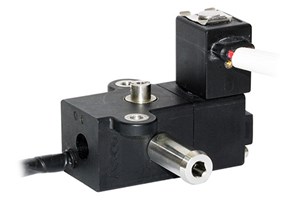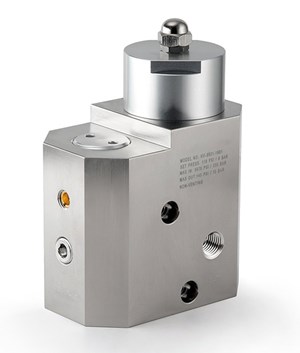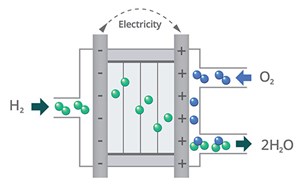Articles
Improve the safety, stability and sustainability of H2 fuel cells
Fuel Cell Application
A. DOYLE, Emerson, Florham Park, New Jersey (U.S.); and C. WANG, Emerson, Shanghai, China
Green hydrogen (H2) is continuing to gain momentum as a key energy source in the global journey toward decarbonization. What makes green H2 an attractive, vital player in this worldwide initiative is its ability to power everything from transportation vehicles to data centers while producing zero carbon emissions.
While renewable energy sources like wind and solar are also part of the path to decarbonization, variable weather conditions can make these renewables intermittent, leading to grid instability. That is where green H2 comes in.
H2 has unique energy-carrying abilities. With three times the energy content of gasoline, H2 can store the energy produced by wind and solar outside of the grid so it can be used when and where it is needed. One critical technology that makes this possible is the fuel cell.
The advantages of green H2 have increased demand for H2 fuel cells to help decarbonize multiple sectors, including transportation and cloud computing. Many H2-powered vehicles are in development and use, from cars, semi-trucks and buses to boats, trains and airplanes, as well as material-handling and industrial vehicles like forklifts and tractors. Fuel cells also provide scalable backup power for data centers, utilities and mission-critical applications. By replacing heavy polluting carbon fuels and chemical battery power with a carbon-free alternative, H2 fuel cells are becoming an important piece of the decarbonization puzzle.
H2 fuel cells offer many benefits; however, to be a successful part of the solution, they must also be safe, stable and sustainable. To achieve this, fuel cell manufacturers and suppliers must possess a high level of expertise in H2’s unique properties and the technologies that support the production and application of H2 as a fuel source. This expertise is especially critical at the component level, where pressure regulators, valves and other technologies are responsible for safely and precisely controlling the flow of H2 into the fuel cell as the gas is converted to usable, carbon-free energy.
Safety begins with control. Because H2 has a low ambient temperature density, it also has a low energy-power-unit volume and must be highly compressed when used as fuel. H2 is subject to pressures of 5,000 psi–10,000 psi (350 bar–700 bar) in tank storage and up to 15,000 psi (1,035 bar) across the value chain. With high-pressure H2 storage tanks and fuel cells replacing traditional gas tanks and petroleum-fueled engines, the filling, storage and transfer of H2 to the fuel cell must address many safety concerns.
First, H2 is highly flammable, and H2 fire is invisible. When H2 comes into contact with oxygen, it has the potential to be explosive if not properly controlled. H2 fuel cells create electricity when H2 flows across the cells, electrochemically reacting with oxygen (FIG. 1). To safely manage the reaction between the H2 and the oxygen, the amount of gases released to the fuel cell stack must remain stable. Flow must be managed using regulators and valves engineered specifically for the task.
To illustrate the importance of properly designed and engineered fuel cell components in ensuring safety, consider a pressure reducing regulator in a fuel cell system onboard a H2 fuel cell electric vehicle (FCEV). Designed specifically to deliver precise H2 pressure to on-vehicle fuel cells, a two-stage regulator can both minimize downstream pressure fluctuations that result from changes in the tank pressure and deliver a consistent flow of H2 as the fuel demands vary during vehicle operation.
Other components that play a part in safety and performance are the valves used for flow control. Proportional valves can provide precise H2 flow control to get varied output power. A proportional valve also subtly manages downstream pressure to prevent overpressure from damaging the fuel cell membrane. Similarly, solenoid valves are ideal for controlling the safe, consistent flow of fuel from the vehicle’s storage tank to the fuel cell stack. Solenoid valves are available for pressure ratings to 435 psi (30 bar), and they can include an optional heating module for cold startups. In very cold environments, the heating module in the solenoid valve, like that shown in FIG. 2, can melt the ice inside the piping. This function allows fuel cell systems to start up quickly.

Components like these specialized regulator and valve designs can also be applied to backup power applications, as the H2 fuel cells used for vehicles employ the same design and technology as those used to store backup power. The main differences are wattage size and system configuration.
To verify regulators, valves and other components being considered for use in H2 fuel cell designs are engineered for safety, manufacturing engineers should reference the component’s regulation and standard compliance. Key standards and regulations to look for include Regulation 134 of the Economic Commission for Europe of the United Nations (UN/ECE), which regulates safety-related performance of H2-fueled vehicles and their components; and, in North America, the American National Standards Institute (ANSI/CSA) Standard HGV 3.1, which governs compliant operation of compressed H2 gas fuel system components.
Stable pressure, stable performance. The fuel system in a H2 FCEV must perform in a wide range of operating modes, including acceleration, deceleration, stopping and idling. These various modes produce varying H2 flow demands that, when left unchecked, can impact fuel cell performance and lower fuel efficiency. In addition, the system is not designed to run the H2 fuel tanks to empty like a traditional gasoline tank, so maintaining the proper fuel pressure throughout the system as the tanks deplete is paramount. With these factors in mind, the system must be designed with components to maximize fuel efficiency and streamline fuel flow to keep vehicles running smoothly on the road for longer before fueling. To achieve this, pressure-reducing regulators and specialized valves once again come into play.
Pressure-reducing regulators with tied-valve and active-seal designs, like that shown in FIG. 3, can stabilize pressure levels within the H2 fuel system during all operating modes and for all levels of fuel. These regulators can help prevent the occurrence of decaying inlet characteristics and H2 leakage that can cause inconsistent and inefficient performance. By precisely controlling H2 flow to respond to system fuel need changes, regulators support dependable performance and optimal efficiency.

Accountable sustainability. Sustainability within the H2 fuel cell industry is a systematic target that cannot be accomplished through one or two isolated initiatives. Achieving it will require the full breadth of the industry value chain to participate—from green H2 production to safe storage and transportation to H2 end use applications.
At the application level, manufacturers of H2 fuel cells are making significant contributions to the sustainability of the industry in three important ways:
- H2 can be produced using other sources of renewable energy, such as wind and solar.
- Decarbonization is realized by the fuel cell’s ability to create electricity from the electrochemical reaction between H2 and oxygen using a zero-carbon emissions process.
- By applying innovative technology to fuel cell designs at the component level, manufacturers can help ensure higher operating efficiency, and safer and more stable performance with lower failure rates and longer fuel cell life.
Additionally, fuel cell manufacturers and suppliers are taking steps toward sustainability by working to source elements that can be reused after a system’s fuel cell stack is retired. As more manufacturers embrace responsibility for the full lifecycle of the fuel cell, greater sustainability of the industry will surely follow and present wider exploration of new H2 fuel cell applications beyond vehicles and backup power.
Partners for a sustainable solution. For H2 fuel cell manufacturers, it is important to partner with suppliers that have expertise in fuel cell technology and offer a comprehensive portfolio of integrated, innovative and proven solutions. Collaborating with experienced suppliers that have H2 and fluid control expertise leads to faster and more dependable project execution, which is becoming increasingly important as the industry grows more competitive and races to scale up. With specialized components for H2 control, like pressure regulators, proportional valves and direct and pilot-operated solenoid valves, fuel cells can deliver safer and more reliable operation. They can also operate with maximum efficiency and offer longer performance life—all of which contribute to a sustainable energy solution.H2T
NOTES
a Emerson’s X968 Series heating drain valve
b Emerson’s TESCOM™ HV-3500 Series hydrogen onboard regulator
About the authors

AKILAH DOYLE is a Product Marketing Manager for Precision Fluid Control at Emerson. She manages new product development projects for high-pressure aerospace and H2 end use applications, including market research, demand analysis, business cases, go-to-market strategies and product obsolescence. Doyle partners with her team to bring system components to market, enabling the efficient use of H2 fuel across the value chain.

CHUN WANG is a Senior Product Marketing Specialist for the H2 industry for Emerson. He has been in charge of new product development projects for fluid control and hydrogen applications for more than 3 yr. In his role, he partners with the H2 team to bring both components and solutions to market, which covers green H2 manufacturing, dispensing and fuel cell usage. His efforts assist customers in achieving carbon reduction goals and accelerate the realization of net-zero emissions.


